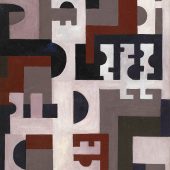Nejib Belkhoja
- Country: Tunisia
- Exhibitions:
- A Century in Flux
- Taking Shape
As one of Tunisia’s key figures in modernist painting, Néjib Belkhodja’s paintings combine experimental form with more classical techniques. In this work, the densely configured architectural elements, with overlapping arches and bands provide the viewer with an abstracted structure. This interest in building structures began in 1987 when Belkhodja joined the architect Slah Smaoui in designing and constructing the artistic village of Ken in Tunisia. Belkhodja studied at the School of Fine Arts in Tunis and began exhibiting locally in 1956. He continued his artistic career in Rome and Paris and was influenced by the art of Robert Delauney and Wassily Kandinsky. He exhibited in Europe and across North Africa and in Egypt. In 1991, he held a joint exhibition in Tunis with the Iraqi artist Dia Azzawi. In 2013, the opening of an exhibition of his work for visiting dignitaries and diplomats caused controversy when Tunisian citizens were banned from the same exhibition. Belkhodja’s art may be seen as a form of modernism that negotiates between the interest in heritage and the liberal vision of modernisation.
نجيب بلخوجة هو أحد أعلام الرسم الحديث في تونس، حيث تجمع لوحاته بين الشكل التجريبي مع التقنيات الأكثر كلاسيكية. وفي لوحته هذه، تساهم العناصر المعمارية المتراصة- إلى جانب الأقواس والأشرطة المتداخلة- في تزويد الناظر بهيكلية مجردة. وبدأ اهتمام بلخوجة ببناء مثل هذه الهيكليات في عام 1987 عندما شارك المهندس المعماري صلاح السماوي تصميم وتشييد قرية كان الفنية في تونس. ودرس بلخوجة في "مدرسة الفنون الجميلة" في تونس، وبدأ بإقامة معارض محلية في عام 1956. وتابع مسيرته الفنية في روما وباريس، حيث تأثر بفن روبرت ديلوني وفاسيلي كاندينسكي. وعرض أعماله في أوروبا وشمال أفريقيا ومصر. وفي عام 1991، أقام معرضاً مشتركاً مع الفنان العراقي ضياء عزاوي في تونس. وفي عام 2013، أثار معرضه الذي استضاف كبار الشخصيات الزائرة والدبلوماسيين جدلاً عندما منع المواطنين التونسيين من الدخول إليه. ويمكن اعتبار فن بلخوجة شكلاً من أشكال الحداثة التي تترنح بين الاهتمام بالتراث تارة والمنظور الليبرالي لمفهوم الحداثة تارة أخرى.




